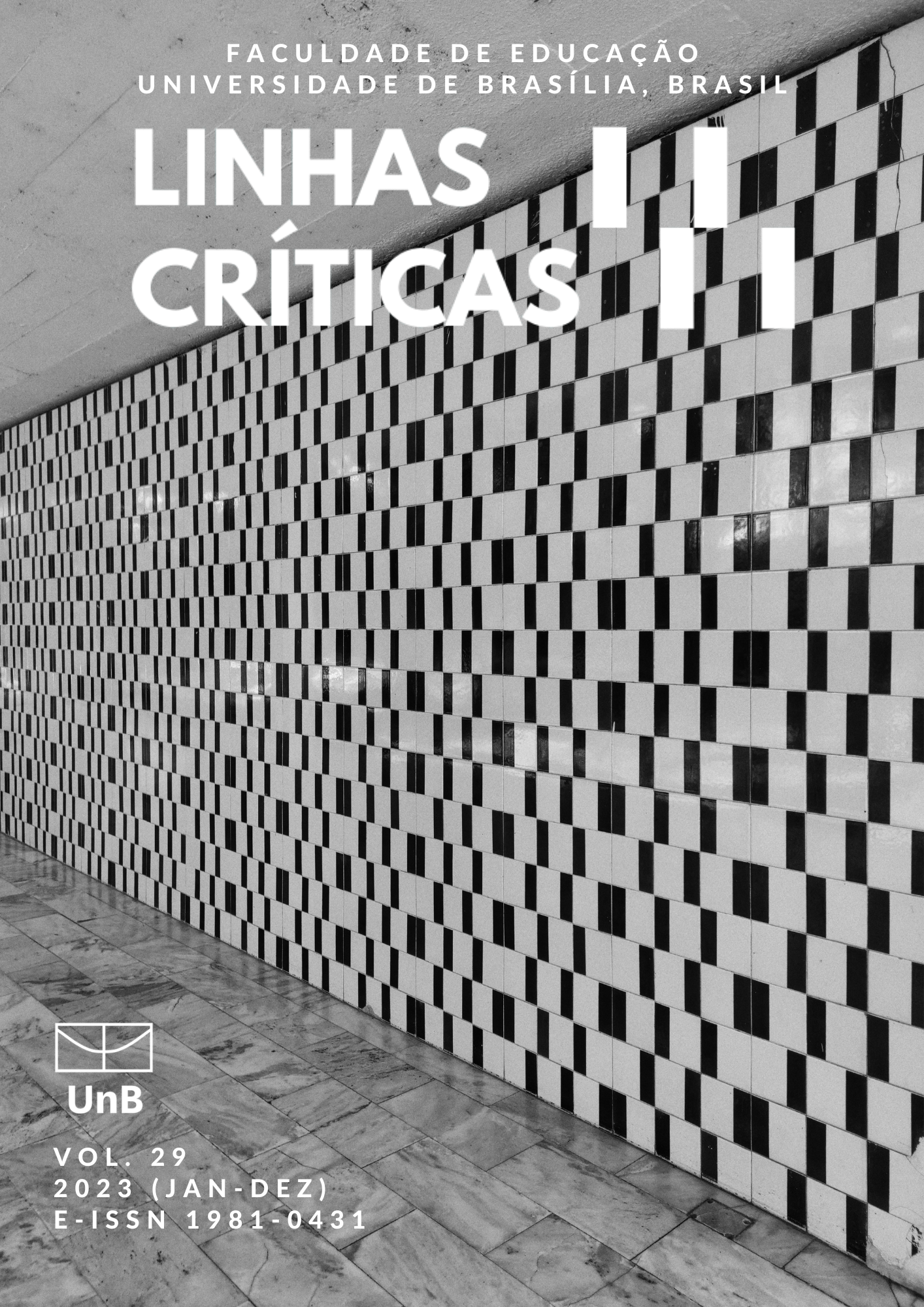Proxemics of children's experiences of risky play in specific leisure equipment
DOI:
https://doi.org/10.26512/lc29202350794Keywords:
Child, Play, Physical Education FacilitiesAbstract
Proxemics studies the relationship between bodies and the space around them. We adopted it as a theoretical-methodological research model for participant observation in territories of risky play. To this end, we conducted a field study in children's playgrounds. Based on the mobilized reference, we found that children self-organize and build, in a relational way, patterns of bodily approximation that reflect their interests in intergenerational or peer relationships. Because of this, we found in children's proxemics a privileged way of listening to and unveiling children's participation, highlighting how they organize their relationship with others and with the territory of play.
Downloads
References
Agamben, G. (2005). Infância e história: a destruição da experiência e origem da história. Editora UFMG.
Barbosa, R. F. M., Martins, R. L. D. R., & Mello, A. da S. (2017). Brincadeiras lúdico-agressivas: tensões e possibilidades no cotidiano na educação infantil. Movimento, 23(1), 159-170. https://doi.org/10.22456/1982-8918.65259
Bowlby, J. (1989). Uma base segura: aplicações clínicas da teoria do apego. Martins Fontes.
Brussoni, M., Gibbons, R., Gray, C., Ishikawa, T., Sandseter, E. B. H., Bienenstock, A., & Tremblay, M. S. (2015). What is the relationship between risky outdoor play and health in children? A systematic review. International journal of environmental research and public health, 12(6), 6423-6454. https://doi.org/10.3390/ijerph120606423
Certeau, M. de. (1995). A cultura no plural. Papirus.
Certeau, M. de. (2014). A invenção do cotidiano: artes de fazer. Vozes.
Corsaro, W. A. (2009). Reprodução interpretativa e cultura de pares. Em F. Muller, & A. M. A. Carvalho (Orgs.). Teoria e prática na pesquisa com crianças (pp. 31-50). Cortez.
Corsaro, W. A. (2011). Sociologia da infância. Artmed.
Fiaes, C. S., Marques, R. de L., Cotrim, G. S., & Bichara, I. D. (2010). Gênero e brincadeira em parquinhos públicos de Salvador (BA). Interação em Psicologia, 14(1), 31-41. http://doi.org/10.5380/psi.v14i1.13465
Freire, J. B. (2022). Prefácio. Em F. Finardi, & C. Ulasowicz (Orgs.). Aprendendo práticas corporais de aventura na educação física: da escola à universidade (pp. 15-17). CRV.
Gomes, C. F., Carvalho, E. L. S. F., & Rohleder, L. S. (2021). Tato e proxêmica: uma reflexão sobre a corporeidade que nos hospeda em tempos de pandemia. Revista Hospitalidade, 18(1), 186-200. https://revhosp.org/hospitalidade/article/view/973/pdf
Hall, E. T. (2005). A dimensão oculta. Martins Fontes.
Lindón, A. (2011). Cotidianidades territorializadas entre la proxemia y la diastemia: Ritmos espacio-temporales em un contexto de aceleración. Educación Física y Ciencia, 13, 15-34. https://efyc.fahce.unlp.edu.ar/article/view/EFyCv13a02/2082
Magnani, J. G. C. (2000). Quando o campo é a cidade: fazendo antropologia na metrópole. Em J. G. C. Magnani, & L. de L. Torres (Orgs.). Na Metrópole: textos de Antropologia Urbana (pp. 15-53). Edusp – FAPESP.
Magnani, J. G. C. (2003). Festa no Pedaço: cultura popular e lazer na cidade. Editora Unesp/Hucitec.
Magnani, J. G. C. (2018). Do mito de origem aos arranjos desestabilizadores. Em J. G. C. Magnani, & E. Spaggiari (Orgs.). Lazer, de perto e de dentro: uma abordagem antropológica (pp. 13-34). Edições SESC São Paulo.
Mello, A. da S., Trindade, L. H., Galvão, E. R., Pimentel, G. G. A. (2021b). O brincar e a criança em tratamento oncológico: relações para além da dimensão terapêutica. Licere, 24, 97-119. https://doi.org/10.35699/2447-6218.2021.34867
Mello, M. B. C. de, Lopes, J. J. M., & Lima, M. F. C. (2021a). Por que rimos das crianças? Linhas Críticas, 27, e35191. https://doi.org/10.26512/lc27202135191
Nunes, L. F., & Santil, F. L. de P. (2020). A segregação socioespacial gerada pela produção do espaço habitacional na cidade de Maringá/PR. Geografia em Atos, 3(18), 78-100. https://doi.org/10.35416/geoatos.v3i18.6980
Parlebas, P. (2014). Praxiología motriz y fenómeno deportivo en el siglo XXI. Acción Motriz, 13(1), 7-20. https://www.accionmotriz.com/index.php/accionmotriz/article/view/73/69
Sandseter, E. B. H., Kleppe, R., & Sando, O. J. (2021). The prevalence of risky play in young children’s indoor and outdoor free play. Early Childhood Education Journal, 49(2), 303-312. https://doi.org/10.1007/s10643-020-01074-0
Santos, M. (2004). A natureza do espaço: técnica, razão e emoção. Editora da Universidade de São Paulo.
Silva Junior, A., Pimentel, G. G. A., & Thomassim, L. E. C. (2021). Oferta de programações esportivas e a participação de crianças: análise de distintos territórios do Paraná. Em R. J. Sonoda-Nunes, A. G. M. G. Pires, A. P. S. Silva Júnior, D. R. Gruppi, I. P. B. Rinaldi, L. E. C. Thomassim, & M. A. F. Freitas Júnior (Orgs.). Políticas públicas para o esporte e o lazer no Paraná: gestão, programas e memória (pp. 123-143). Editora UEPG.
Published
How to Cite
Issue
Section
License
Copyright (c) 2023 Giuliano Gomes Assis Pimentel, And´ré da Silva Mello

This work is licensed under a Creative Commons Attribution 4.0 International License.
Authors who publish in this journal agree to the following terms:
-Authors maintains the copyright and grants the journal the right of first publication, the work being simultaneously licensed under the Creative Commons Attribution License which allows the sharing of the work with recognition of the authorship of the work and initial publication in this journal.
- Authors are authorized to enter into additional contracts separately, for non-exclusive distribution of the version of the work published in this journal (eg publish in institutional repository or as a book chapter), with acknowledgment of authorship and initial publication in this journal.
-Authorers are allowed and encouraged to publish and distribute their work online (eg in institutional repositories or on their personal page) at any point before or during the editorial process, as this can generate productive changes as well as increase the impact and the citation of published work (See The Effect of Free Access).



